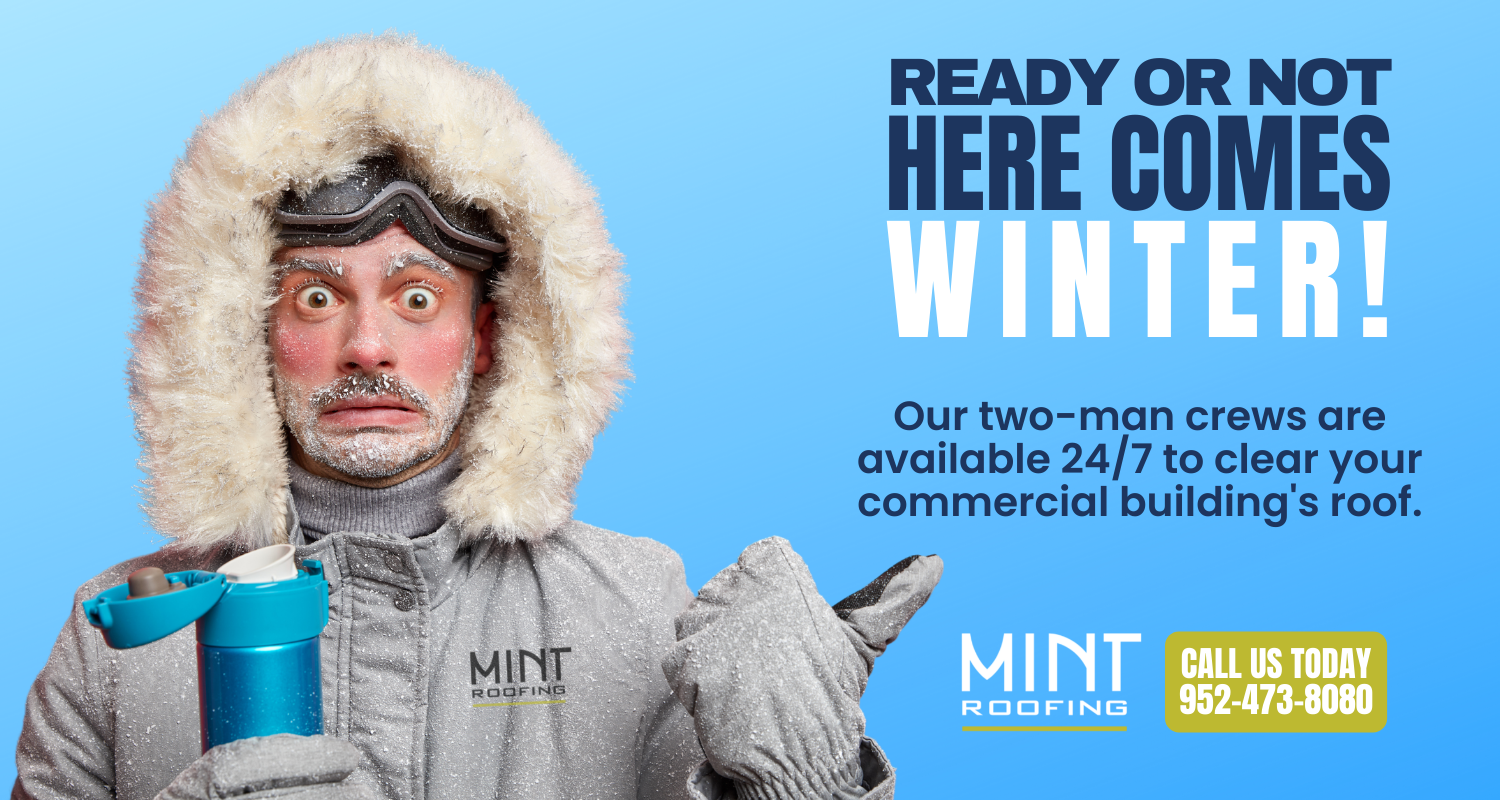Commercial Roof Maintenance During the Winter Months
This time of year can be problematic for your commercial roof. Snow and ice accumulation, freezing and thawing temperatures, and the potential for leaks all make it essential to maintain your commercial roof this winter.
Luckily, you can take some simple steps to protect your commercial roof from damage during the cold season. This blog post gives you 6 tips to help you maintain a healthy commercial roof over the winter!
1. Regular Snow and Ice Removal
It’s critical to clear your flat roof of excess ice and snow in the winter. Snow adds tremendous weight to the top of a flat roof. Too much accumulating snow can put undue stress on your roof and even lead to roof collapse in some extreme cases. Deep snow compacts over time and will eventually turn to solid ice.
Ice buildup can block your commercial roof’s drainage system, causing water to pool during melting cycles. If melting snow and ice cannot reach the drainage system, it will find another way to the ground.
Scheduling regular inspections throughout the winter months can help prevent many common issues.
If you don’t have the manpower to perform these inspections, consider hiring experts. They have the tools and knowledge necessary to complete this work, allowing you to focus on more important things – like running your business.
2. Beware of Ice Dams on Your Commercial Roof
Poorly insulated roofs are especially susceptible to ice dams – a layer of water that pools between the roof’s surface and a layer of ice caused by warm air inside the building. The melting continues between the ice and the roof, with nowhere to go.
The pressure of this ice can force this pooled water to penetrate weak points in your roof membrane or flashings. The result is leaks and water damage to the interior and contents of your building.
Even well-maintained roofs can fall victim to ice dams. They tend to be as much an indicator of structural deficiency as they indicate a defective roof.
3. Monitor Freezing and Melting Cycles
Minnesota winters tend to vary significantly between cold and mild temperatures, especially during the early and late parts of the season. As stated above, these freeze/thaw cycles are the periods that cause the majority of winter commercial roof leaks.
A good comparison is water pipes. Frozen pipes don’t leak, but once they thaw, the water creates enormous pressure that can cause even metal pipes to expand and burst.
Commercial roofs are very similar to water pipes. When everything is frozen, you don’t have much to worry about. Once thawing begins, the chance of leaks increases exponentially.
4. Keep Drainage Systems Clear
This can be a difficult, if not impossible, task during a Minnesota winter. While commercial roofs are designed to drain year-round, winter presents some serious challenges. Plummeting temperatures after a wet snowfall can cause drains and downspouts to freeze up, blocking drainage when thawing occurs.
Keep a close eye on your drainage system and make sure that all downspouts are clear of debris and ice. If necessary, use a heat gun to melt any ice built up in the system. Care must be taken not to overheat the roof components or seals. When in doubt, hire a professional roofing company like Mint Roofing to deal with freeze-ups.
5. Make Sure All Vents and Chimney Pipes are Clear of Snow or Ice
Blocked ventilation venting and chimneys can lead to all sorts of problems, including carbon monoxide buildup, moisture accumulation, roof deterioration, and even fires. Chimney pipes need to be tall enough to stay above any accumulated snow. If you’ve recently acquired your building, it is recommended that you have your roof inspected to make sure the venting and chimney stacks are tall enough and in good condition.
Heating systems can help, but be sure that your system is professionally designed. A poorly designed system could actually create more problems.
If vents become blocked by snow or ice, moist air can be forced into the building, where it will condense on colder surfaces, such as metal or concrete, potentially resulting in water damage to the interior of your structure. This is one of the most common causes of leaks during the winter months.
Once again, regular inspections can help prevent many issues from occurring.
6. Leave Winter Commercial Roof Maintenance to the Professionals
Regular inspections, especially during the winter months, can help you avoid many problems. This is not something that most property owners have time for or even understand how to do correctly.
After a heavy snowfall, you may not even be able to access your roof because your “hatch-style” access door is covered by a heavy blanket of wet snow. In this case, a commercial roofing contractor like Mint Roofing can access your roof from the outside with special equipment.
Professional roofers are there in the event of an emergency. They will be able to handle all types of weather conditions – from heavy snows to winter rainstorms and everything in between.
Residential roofers do not have experience with this type of specialty work. They could cause more damage to the property if they try fixing a commercial roof themselves. Leave all winter maintenance to professional contractors specializing in these types of projects. Professional roofing companies are experts at determining when problems arise from winter weather and will know exactly how to address them.
We’re here to help!
The commercial roofing professionals at Mint Roofing are here to help you keep your commercial roof performing at its best through the challenges of a Minnesota winter.
Need help clearing snow or ice? Give us a call. Our 2-man crews are available 24/7 to keep your roof clear of snow and ice. Signing up for our TopSite Preventative Maintenance Program is the easiest way to keep your commercial roof in Tip Top condition all year round.
Give us a call at (952) 473-8080 or email us at info@mintroofing.com today and leave your winter roof worries to us!

FAQs
Q: Why is it important to remove snow and ice from my commercial roof during winter?
Answer: Removing snow and ice from your commercial roof is crucial to prevent excessive weight that can stress your roof and block drainage systems, potentially causing leaks and damage. Regular removal also ensures the safety and integrity of your roof during winter.
Q: What are ice dams, and why should I be concerned about them?
Answer: Ice dams are layers of water trapped between ice and your roof, caused by warm air inside the building. The pressure from ice dams can lead to water penetrating your roof, resulting in leaks and interior damage. Even well-maintained roofs can experience ice dams.
Q: Why do freezing and melting cycles pose a threat to my commercial roof during winter?
Answer: Freezing and thawing cycles can cause materials in your roof to expand and contract, leading to potential leaks and damage. Just like frozen pipes burst once they thaw, commercial roofs are susceptible to leaks during thawing periods.
Q: How can I keep drainage systems clear during a Minnesota winter?
Answer: Winter can present challenges for keeping drainage systems clear due to freezing temperatures. It’s essential to monitor your drainage system, clear debris, and ice, and use appropriate methods, like a heat gun, to ensure proper drainage. To be safe, consider hiring professional roofing services.
Q: Why is it important to ensure that all vents and chimney pipes are clear of snow or ice?
Answer: Blocked ventilation and chimney pipes can lead to a range of problems, including carbon monoxide buildup, moisture accumulation, roof deterioration, and even fires. Regular inspections and professional design of heating systems can help prevent issues related to blocked vents during winter.


